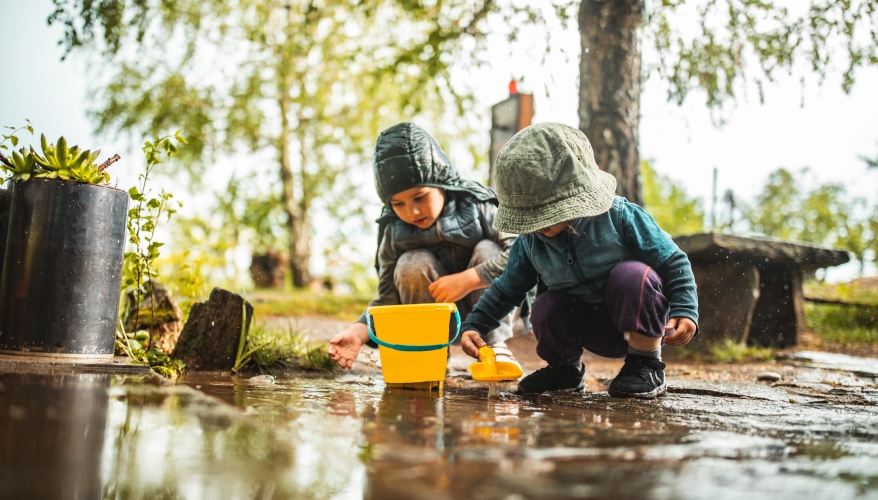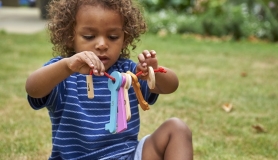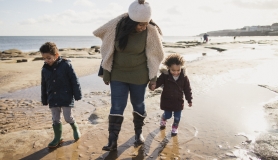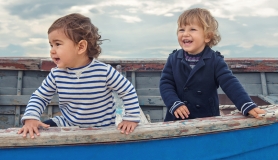Jean Piaget said “play is children’s work”, but the truth is it can be work for adults too. Not only in the sense that we learn through play, as children do, but also in the sense that entertaining little ones for the third wet day in a row can be a real challenge. Waterproofs and puddle splashing are great fun, but come rain or shine we all feel like staying home sometimes.
It can seem that one’s ability as a parent is measured by the fullness of our children’s diaries. But playing at home can offer an opportunity to explore in ways we can’t do elsewhere. Play dates and groups provide much needed social contact for all, but staying in allows us to focus on our children exclusively. It can be tempting to see play as something children should do to occupy themselves, while we get on with running the household, chatting to friends, or getting some much needed “Me time”. When we are in this mode our children’s desire to play with us can become a frustration. But if we can really engage with our little ones, and enter the world of their play, it can be a great bonding experience through which we can learn a lot about our children and ourselves, and develop our relationship.
For young babies anything and everything is a sensory epiphany, and they are often content to experience the world around them through all their senses: parents need do little more than facilitate this. Children are driven to explore their environment, and as soon as they are mobile this compulsion to learn is expressed through pulling the books from the shelves, attempting to climb the stairs and dragging the pans from the cupboard. It can be good, for us and them, to occasionally set something up which gives them sensory input, and gives us a different experiment to tidy away!
Containing the mess!
Many little children love messy play, but the “M” word can, understandably, put us parents off. My house is messy enough before the kids even get going. So strategies for children to indulge their love of goo that don’t cause a parental breakdown are important. Getting outside is a good idea, especially if a paddling pool is set up, or it’s warm enough for a hose down. But if it’s cold, or you don’t have access to outside space, containment is the name of the game. The bath can be your friend. Squirming mucky pups can be carried straight there (wear an apron as you lift them up) or it can be the site of play itself. Add food colouring, blocks of ice containing toys, foam soap, floating balls and balloons, or glow sticks in the dark for a great sensory experience. Sponges, cups, watering cans and colanders are old favourites. We have allowed our children to paint the bath, and to draw all over it with crayons, both of which cleaned off easily and fulfilled their needs to make big marks and explore drawing on unusual surfaces.
Playing with food
Food can be a play opportunity too, especially for little ones who are just beginning solids. Natural yoghurt provides a wonderful medium for little babies to play with colour. Spread the yoghurt across the high chair tray and add a few drips and drizzles of fruit coulis or natural food colouring for your infant to mix, spread and eat as they like!
The high chair is a great messy play resource for those just sitting up but once your child discovers pulling themselves up to stand they are seldom content to be in the chair for long. This is when an inexpensive sand and water table can be really useful. Outside, or inside with a tarpaulin, newspaper or disposable dust sheet under, the table can be filled with all manner of edible play things, from crisped rice cereal to mounds of cold instant noodles (no sachet of flavour needed!). These may not be things you would feed your precious ones every day, but they won’t consume much. Nevertheless always be aware of the risk of choking. Or try adding these things to a small paddling pool (inside with the floor protected, or outside) – you can also experiment with popped corn, balls, paint or just good old water.
Once your little one is past the point of putting everything in their mouth a world of possibilities opens up: small grains or seeds, goops such as cornflour and water and small shells, pebbles and stones. My friend’s son’s favourite pastime is to fill bottles with gravel! Sand is hard to beat, add water and the possibilities are endless.
Artistic license
If you can be a bit freer with mess, for example if you have easy to clean flooring or access to outside space, large painting can be great fun. My little boy loves using his whole body as a brush, but be aware that it can be slippy underfoot. Rolls of cheap lining or wall paper are a great canvas, even rolls of paper tablecloth sold for BBQs can be good if not too thin (double up if they are).
Through painting with my eldest, I discovered that it’s hard to predict quite how a child will play with something especially when, as adults, we have preconceived ideas about the “correct” way. I set out several colours of paint on a plate, gave him a brush, water and sheet of paper, and honestly expected he would copy me, making marks on the paper. In fact he played with the water lots, wanted to touch the paint, to rub it on his body, made stabbing motions with the brush that offended my art school sensibilities, and then wanted to see where the paint had come from. This is when he discovered squeezing the bottle and letting the viscous pigment flow on to his legs. He loved it. It might not be what I thought paint was for, but it was clearly deeply satisfying for him. It was filling some urge that I didn’t get, but which was obviously developmentally appropriate for him at that time. I stocked up on loads of paint in the sale, and next time we used huge paper he could stand on. For a long time painting was more about painting himself, literally, than making images. Through this I learnt to let go of ideas about what my children’s play should look like. I realise that their innate desire to explore and learn urges them to play with things in ways I would not predict, sometimes to the point of destruction. While I help them to look after things I know they value for future play, I also respect that when I give them things to play with I should not dictate the form that play should take.
Boundless energy
When you can’t get out and need to burn up some of that boundless toddler energy, it can be worthwhile pushing the furniture aside to create the largest space you can. In that space you can utilise a variety of chairs, stools and steps to create climbing opportunities. Going over, under and through helps little ones get the gross motor stimulation that they need. Obstacle courses incorporating boxes to get in to, masking tape lines to jump from, and sheets to crawl under are another option. Climbing on to a step or chair to drop a parachute, or roll a ball down a cardboard slope, can give the legs some work. Always be aware of your own child’s competences and safety when setting this up. While the furniture is out of the way don’t forget to have a bop! Turn the music up, draw the curtains, perhaps a few torches could add to the disco vibe.
Dens, forts and castles are wonderful for make believe play. There are lots of play tents available to buy, but making one can’t be bettered. Outside, bamboo cane teepees with a blanket held by pegs are a classic. Indoors, the clothes horse is fab, as is a ridge tent design using two chairs and a pole or cane. A snack or even a nap in a tent beats one in the usual place. If you are unsure about how to engage in imaginary play with your children, use a favourite film or book as a starting point, modifying the plot or introducing other characters as the game develops.
Waste not, want not
All sorts of random things can be great “toys.” A great source of inspiration could be your local scrap store. One near us takes in all sorts of odds and ends that someone might find useful and sells them really cheaply. I go every few months and for a few pounds fill a bag with bits and pieces to keep in reserve for when we need some stimulation. Favourites have included a huge wad of metallic cellophane (it has been streamers, fire, water, giant confetti and more), a 15m long strip of industrial felt with small circles cut out (it has been a road, a roof, a path, and we have played under, in and on it), and a plastic mirror ball (crawling babies have chased it across the floor, we have shone lights at it, spun it and of course had a disco with it!).
Alongside that my views on waste have developed. For instance, in the paint example above I could have viewed my son’s desire to pour paint on his body as a waste, certainly my first reaction. I could have given him only enough to make a picture, in line with my views of how paint should be used. No doubt the bottles would have sat on the shelf till the contents solidified. That would have been a waste. But also my son’s natural curiosity would have been squashed and that would have been the greatest waste of all. We reuse, recycle and compost what we can and I see the things we consume as resources I am investing in my children.
Winding play down
Play should be fun for parents too, but it can be hard to stay engaged and in the moment when energy and mess levels are rising. How will we calm the little ones down before things get too crazy? The trick is not to present it as calming down, which can read as “stop having fun!”. Instead transition from one exciting thing to another. From body paint to a bubble bath with food colouring, and then to a snack enjoyed inside a den. Switch from running and jumping to a copying or dancing game, and then to yogic deep breathing with eyes closed. Or from worm hunting to a paddling pool to a cuddle in a tent. This is much more likely to succeed if you can be genuinely in the moment, enjoying your child’s play.
So don’t fear the mess. Don’t try and sneak off. Let go and join in! It’s child’s play…
Dawn is a freelance artist and writer. She lives in Yorkshire with her two young children.
WHAT TO READ
Playful Parenting Lawrence J Cohen
50 Fantastic Ideas for Messy Play by Sally Featherstone
RAINY DAY INSPIRATION
- Make a ramp to roll balls down
- Fly paper planes in to targets
- Make two different dens
- Create hopscotch with masking tape
- Use wool or string to lay out a race track for toy cars
- Create a mini camp for toy animals
- Pile all the cushions on the floor and jump and flop on them
- Make a lot of pop corn. Use the popcorn to hide objects in a bowl. Can you identify them by feeling around?
- Make a saucepan drum kit
- Draw the curtains and put on a torch shadow puppet show
- Have a bath with some food colouring
- Play ice Limbo! (broom handle across chairs) Can you roll under it? Or go backwards?
- Draw on windows with washable pens (check they wipe off)
- Blow up balloons. Put pinches of rice or lentils in some before tying them off
- Blutack paper to the underside of the dining table, lie under it and draw with your toes. You may need to prop under the hips with cushions.
- Make a tower from rolled up newspaper
- Get in the empty bath and paint your bodies before filling the tub







